Vintage Gemstone Rings: An In-Depth Exploration
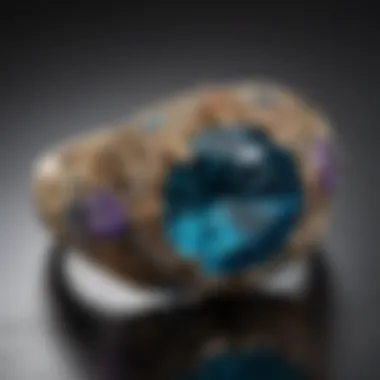
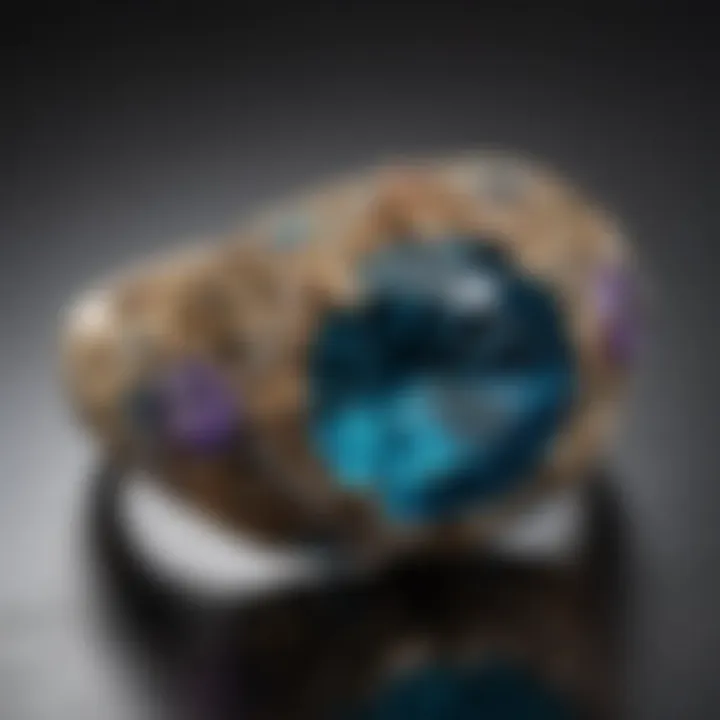
Intro
When one takes a moment to gaze at a vintage gemstone ring, it’s not just the sparkle that captures the eye; it’s also the story woven into each delicate facet. These rings embody craftsmanship from a bygone era, reflecting unique styles, cultural significance, and, ultimately, the artistry that defines them. For aficionados and casual collectors alike, understanding the world of vintage gemstone rings is like peeling back the layers of a rich tapestry, each thread revealing something more about the past.
This guide is crafted for those curious minds who want to explore the depth of vintage gemstone jewelry. From the definition and characteristics of gemstones to a closer look at their properties, we’ll embark on this journey together to appreciate not just the beauty, but also the significance of these stunning pieces.
As we step into the various aspects of vintage gemstone rings, we’ll highlight the types of gemstones, their history, and what makes them cherished items today. In addition, practical advice on care, ethical sourcing, and appraisals will equip you with the tools necessary to better appreciate and care for these treasures.
Let’s dive into the first section, where we will define what gemstones are and classify them by their various characteristics.
Historical Context of Vintage Gemstone Rings
Understanding the historical context of vintage gemstone rings is like holding a mirror to our past. It not only unravels the significance of these beautiful pieces but also highlights the evolution of human creativity and expression through adornments. Rings have always held a special place in cultures worldwide, symbolizing various sentiments ranging from love and commitment to status and wealth. By exploring ancient civilizations and their relationship with gemstones, one can grasp the depth of meaning and craftsmanship that these rings carry through centuries.
The journey of gemstones in jewelry showcases humanity's quest for beauty and value, making it essential for enthusiasts to appreciate the intricate stories behind the pieces they treasure today. Over time, styles have transformed, influenced by social changes, technological advances, and cultural exchanges. This rich tapestry of history adds layers of charm to vintage rings, offering not just an accessory but a narrative steeped in tradition.
Ancient Civilizations and Gemstones
Across ancient civilizations, gemstones were revered not only for their beauty but also for their perceived powers. The Egyptians, for example, adored turquoise, which they believed provided protection in the afterlife. They intricately carved these stones into amulets, complementing the elaborate gold and lapis lazuli jewelry worn by pharaohs.
In Mesopotamia, lapis lazuli was highly prized. Its vibrant blue was associated with the divine, and so, it adorned the necks and wrists of the affluent. The significance of gemstones was omnipresent; they were often thought to possess healing properties or serve as conduits for celestial energies.
The Romans also joined the fray with their penchant for opals and emeralds, which they associated with hope and love, respectively. Wealthy individuals donned rings with various gemstones, transforming them into symbols of status and sophistication. This early interaction with gemstones shaped the foundation of what modern jewelry would become.
The Evolution of Jewelry Styles
As societies evolved, so did their tastes and understandings of style. The romantic period, for instance, marked a significant shift in jewelry design. People began to favor intricate detail over the overt opulence seen in earlier eras. Victorian rings became known for their sentimental motifs, often encapsulating locks of hair or love tokens within jewel-encrusted designs.
Art Deco emerged in the 1920s, casting aside the floral and romantic aesthetics of the past for a more geometric, streamlined look. The use of bold colors, including vivid sapphires and rich emeralds, became notable in this era. Rings from this period often featured striking contrasts and were considered a celebration of modernism.
Today, vintage rings encompass a variety of styles, each embedding history into its design. Collectors and jewelry designers often draw inspiration from these eras, ensuring that the stories of those who came before are not lost but instead cherished anew. Each ring, therefore, speaks not just to the aesthetic sensibilities of its time but also to the evolving nature of human connection.
"Rings tell stories, not just of the wearers but of the times they came from. They hold the whispers of history that resonate through gems and settings."
In summary, by examining the historical context surrounding vintage gemstone rings, we can appreciate their true value—not only as decorative items but as enduring reminders of human expression, connection, and artistry. This appreciation enhances one's ability to acquire, care for, and celebrate these remarkable creations.
Unique Features of Vintage Gemstone Rings
When it comes to vintage gemstone rings, their unique features set them apart from modern mass-produced jewelry. This distinction stems from a combination of craftsmanship, historical context, and the individual story each piece tells. As collectors and enthusiasts delve deeper into this niche, understanding these features can greatly enhance appreciation and value.
Craftsmanship and Design Techniques
Craftsmanship in vintage gemstone rings reflects the hands-on skill of artisans who often relied on time-tested techniques. Unlike today’s computer-generated designs, many vintage pieces showcase intricate handwork that speaks volumes about an era's dedication to artistry and detail. For instance, the art of stone setting varies widely across periods, with techniques such as bezel, prong, and pave settings each requiring meticulous precision.
In the Victorian era, designs often integrated detailed filigree work, giving rings an enchanting delicacy. The Edwardian period, on the other hand, favored a more decadent style with elaborate motifs and the use of platinum that allowed for intricate designs without compromising strength. This handcrafting approach means that no two rings are exactly alike, lending a personal touch to each piece.
Moreover, the choice of gemstones and their treatment methods can reveal an astonishing amount about the ring's origin. For example, sapphires and emeralds of earlier times were often left untreated, enhancing their raw beauty. Modern gemstones tend to undergo various enhancements, which can diminish some of the appeal for collectors who cherish originality above all else.
Styles Across Different Eras
The evolution of styles in vintage gemstone rings is fascinating and offers a lens through which to understand changes in societal values and aesthetic preferences. Each era, from the Baroque through Art Deco, injected its unique flavor into jewelry design.
- Baroque (1600s-1750s): Known for overly ornate styles, Baroque rings often utilized large gemstones surrounded by elaborate filigree. The rings featured rich colors and were heavy in appearance.
- Georgian (1714-1830): This style often showcased organic and nature-inspired designs featuring closed-back settings, which were popular for keeping gemstones secure as well as allowing them to catch light beautifully.
- Victorian (1837-1901): Characterized by sentimental themes, this era’s rings often featured lockets or cameos, integrating personal elements into the design. Gemstones like garnets and pearls were particularly favored.
- Art Nouveau (1890-1910): Emphasizing a natural aesthetic, this style incorporated flowing lines and curves, with gemstones often set into whimsical designs that resembled organic forms.
- Art Deco (1920s-1930s): With a move towards symmetry and bold geometrical shapes, this era embraced color contrasts and innovative materials like diamonds set in platinum.
Understanding these different styles allows collectors to not only appreciate a ring's beauty but also to recognize its place in history. Notably, vintage rings may also benefit from revival trends, as many of today’s designers draw inspiration from these rich historical styles.
"Collecting vintage gemstone rings is akin to holding a piece of history in your hands, where the story of art, love, and craftsmanship intertwine."
Popular Gemstones in Vintage Rings
When it comes to vintage gemstone rings, the choice of gemstone often amplifies the ring's aesthetic and symbolic value. Each gem carries distinct meanings and benefits, making them not just decorative pieces but also vessels of emotions, stories, and heritage. In this section, we will dive into the significant gemstones that have graced vintage rings throughout history, highlighting their unique characteristics and cultural importance.
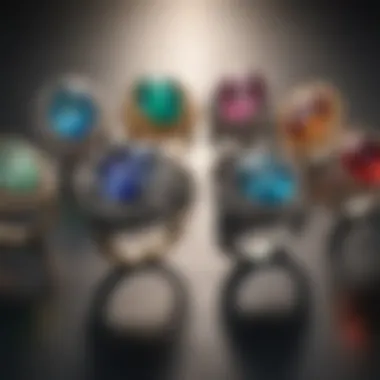
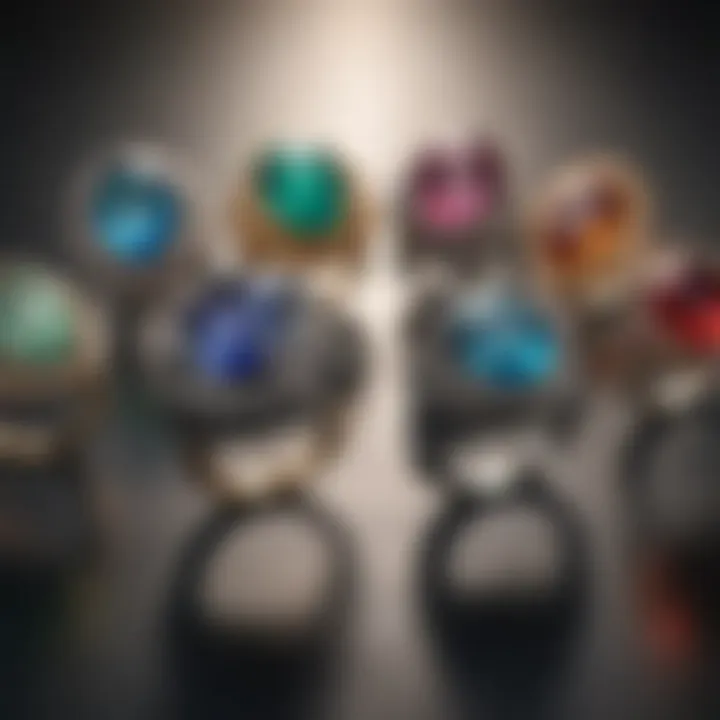
Sapphires: Symbol of Wisdom
Sapphires have long been celebrated for their deep blue hue, often associated with wisdom, nobility, and protection. In ancient times, these stones were thought to empower their wearers with knowledge and insight, which is why they were favored by clergy and royalty. The allure of sapphires extends beyond their color; the hardness of this gemstone makes it an excellent choice for everyday wear, thus maintaining its beauty over time.
Not only do sapphires come in brilliant blues, but they can also appear in an array of colors. This variety allows for versatility in design, appealing to diverse tastes. Many vintage rings feature sapphires in intricate settings, often surrounded by smaller diamonds or other colored gemstones, enhancing their depth and richness.
Emeralds: Emblems of Love
Emeralds embody the essence of love and rebirth. In various cultures, they symbolize fertility, growth, and the healing power of love. Their lush green hues often evoke thoughts of nature, renewal, and harmony. Vintage emerald rings are frequently adorned in intricate designs, showcasing their mesmerizing green in an elegant display.
Notably, emeralds can be somewhat delicate. Unlike sapphires, they require a careful approach to maintenance. Potential owners should be mindful of their treatment; subtle care will help retain the vibrant luster of these gemstones. The blend of their beauty and significance continues to make emeralds a popular choice for vintage rings, especially in romantic contexts.
Rubies: Passionate Allure
Rubies, with their rich red tones, are often associated with passion and energy. Historically, they were thought to bring good luck, protect against evil spirits, and promote a prosperous life. Ruby rings have an undeniable allure that captures the essence of love and desire, making them perfect as engagement rings or tokens of affection.
In vintage pieces, rubies are commonly set in designs showcasing intricate detailed metalwork, often paired with diamonds for an added layer of brilliance. Collectors appreciate rubies not only for their striking color but also for their rarity and value, making these rings a worthy investment as well.
Opals: Mystical Appearances
Opals present a fascinating kaleidoscope of colors. Their play-of-color phenomenon captivates gem enthusiasts; the shifting hues can evoke feelings of mystery and allure. Afire with potential, opals have been steeped in superstition, being regarded as a protective stone that brings good luck to those who wear them. Historically, they were favored by those looking to ignite creativity and spontaneity, adding to their charm.
Vintage opal rings often stand out due to their unique ability to blend in colors of reds, greens, blues, and yellows, creating a captivating centerpiece. It’s essential, however, to handle opals with care since they are softer than many other gemstones. With proper maintenance, the beauty of opals can be retained for generations.
"The right gemstone is not just a piece of jewelry; it's a piece of your identity."
Each of these gemstones adds not only value but also distinct meaning to vintage rings, enriching their history and appeal for collectors and enthusiasts alike. In appreciating these stones, one can foster a deeper connection to the narratives they hold, which continues to endear them to future generations.
Metaphysical Properties of Gemstones
The allure of vintage gemstone rings goes beyond their aesthetic appeal; they are often steeped in metaphysical properties that have fascinated humans for centuries. As we delve into the realm of gemstones, understanding their supposed benefits can enrich the experience, not just for collectors, but for anyone who wears or appreciates these remarkable pieces. Gemstones have been attributed various healing qualities and serve important roles in spiritual practices, making them more than mere adornments.
Healing Qualities of Gemstones
Many believe that gemstones possess unique healing properties that can influence physical, emotional, and spiritual well-being. Different stones are thought to offer diverse benefits, and enthusiasts might find themselves gravitating toward specific types based on personal needs or ailments. Here are a few examples:
- Amethyst: Known for its calming energy, this purple stone is often linked to alleviating stress and anxiety. It's believed to enhance mental clarity and promote a peaceful mind.
- Rose Quartz: Often dubbed the "love stone," this gentle pink gemstone is associated with emotional healing, particularly in fostering self-love and compassion, as well as fostering harmony in relationships.
- Lapis Lazuli: This deep blue stone is said to enhance awareness, encouraging self-expression and illuminating the path to personal truths.
In choosing a vintage gemstone ring, collectors may sometimes prioritize these perceived qualities alongside beauty. The healing attributes can provide a deeper, enriching connection to a ring, transforming it into something personal and meaningful. Many often keep these stones close, using them as talismans, believing that their energy can protect or rejuvenate the wearer.
Gemstones in Spiritual Practices
It's not uncommon for gemstones to play a pivotal role in various spiritual practices across many cultures. Often viewed as conduits of energy, these stones may facilitate meditation, rituals, and other spiritual activities. This section provides an overview of how gemstones interweave with spirituality:
- Meditation Tools: Practitioners may use crystals during meditation to aid focus or enhance intuitive awareness. Common selections include clear quartz, which is considered a master healer, and citrine, said to bring positivity.
- Ritualistic Uses: In many cultures, gemstones have been used in rituals for protection and enhancement of spiritual energy. For instance, black tourmaline is often utilized as a protective stone against negative energies.
- Chakra Work: Many adherents to energy healing practices recognize the significance of gemstones in balancing chakras, the energy centers within the body. Each stone aligns with specific chakras, promoting harmony within the individual. For example, a garnet may be used for the root chakra, encouraging grounding and stability.
- Gifts of Intention: Often, gemstones are given as gifts laden with intentions for healing, protection, or growth, imbuing them with an additional layer of significance.
"Each gemstone carries its own unique frequency and energy, influencing those who are open to their powers."
In summary, the metaphysical properties of gemstones go beyond the surface, adding layers of meaning and emotional resonance. Whether one seeks healing, guidance, or insight, these stones have become intertwined with personal stories and spiritual journeys, making vintage gemstone rings much more than just beautiful ornaments.
Caring for Vintage Gemstone Rings
Caring for vintage gemstone rings is a vital aspect that any proud owner or enthusiast should consider. Just like a delicate flower in a garden, these rings require proper attention to maintain their beauty and integrity. To some, vintage gemstone rings may simply be lovely adornments. However, for true lovers of jewelry, they represent history, artistry, and heritage. Their preservation is paramount, not just for aesthetics but also for their financial and sentimental value.
Proper care can help ensure that these tangible memories can be enjoyed for generations to come. Vintage rings often feature intricate designs and are made from materials that can be sensitive to the elements. The right cleaning and storage techniques can protect these treasures from wear and tear.
Cleaning Techniques
Cleaning vintage gemstone rings can seem daunting, but it doesn't have to be. Firstly, one should avoid harsh chemicals, which can damage delicate settings or fade the gemstones. Instead, a mild soap solution is often recommended. Here's a simple step-by-step cleaning process:
- Prepare the Solution: Mix a few drops of mild dish soap into warm water.
- Soak the Ring: Submerge the ring for around 15-20 minutes. This allows any dirt or oils to loosen.
- Gently Brush: Use a soft-bristled toothbrush or a jewelry cleaning brush to work around the stone and setting. Be careful not to scratch the surface.
- Rinse the Ring: Rinse under lukewarm water, ensuring that all soap is removed.
- Dry Thoroughly: Use a lint-free cloth to gently dry the ring. Make sure to pat it dry, especially in crevices where moisture can hide.
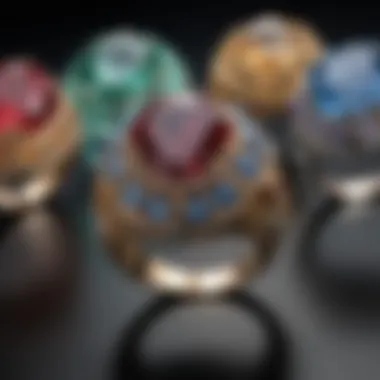
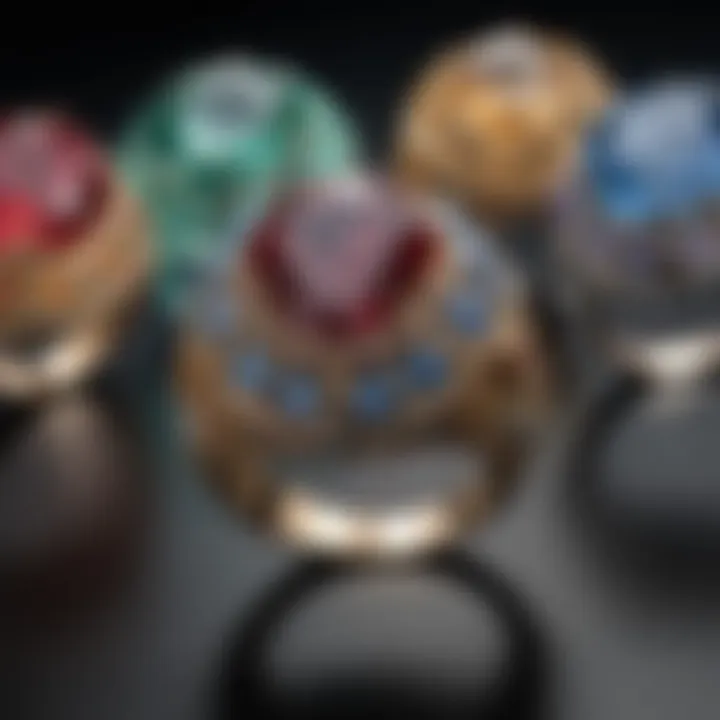
For particularly stubborn grime or for rings featuring porous stones like opals, seeking professional cleaning is advisable.
Important Note: Always check with a jeweler if you're unsure about the best cleaning method for your specific gemstone.
Proper Storage Solutions
Storing vintage gemstone rings properly is as crucial as cleaning. Each ring has unique requirements based on its design and materials.
- Separate Boxes: When storing multiple rings, it’s wise to place each in its own box or pouch. This prevents scratching each other.
- Silk or Velvet Pouches: Consider using soft, breathable materials to protect the rings from dust. Such fabrics can also absorb moisture.
- Avoid Direct Sunlight: Store your rings in a cool, dark place. Excessive sunlight can cause fading or, in some cases, damage to certain stones.
If you intend to display them, using lined boxes helps maintain conditions that minimize wear and damage.
"Taking the time to care for your vintage gemstone rings is not just a labor of love; it's an investment in the stories they hold and the beauty they bring."
In summary, appropriate cleaning and storage techniques are essential for preserving the longevity and luster of vintage gemstone rings. By keeping these practices in mind, enthusiasts can ensure that these pieces of history are cherished and maintained as the valuable treasures they truly are.
Evaluating the Value of Vintage Gemstone Rings
Evaluating the value of vintage gemstone rings is essential for anyone interested in these exquisite pieces of jewelry. Whether you are a collector, enthusiast, or simply looking to inherit a cherished family heirloom, understanding value can guide conversations when buying, selling, or appraising these treasures. The worth of a vintage gemstone ring hinges on multiple elements, making a comprehensive evaluation critical.
Factors Influencing Gemstone Value
The value of any vintage gemstone ring is not fixed; it varies based on a variety of factors.
- Gemstone Quality: The quality of the gemstone plays a pivotal role, encompassing attributes like color, clarity, cut, and carat weight. For instance, a well-cut, vivid blue sapphire is likely to command a higher price compared to a pale, poorly cut one.
- Rarity: Rarity can greatly enhance a gemstone's value. Unique specimens, such as rare colored diamonds, often fetch steep prices due to their limited availability.
- Provenance: The history and journey of the gemstone ring can also impact its worth. Rings owned by famous figures or linked to significant events tend to be more valuable.
- Craftsmanship: The artistry behind the piece is important too. Rings that exhibit exceptional craftsmanship, particularly from renowned jewelers, often appreciate in value.
- Market Trends: Value can fluctuate with market demand. Trends in jewelry can shift seasonally or due to broader economic conditions. Keeping an ear to the ground on what's in vogue can aid in understanding the right price range.
These factors intertwine, shaping a multifaceted understanding of gemstone ring value.
How to Get an Appraisal
Getting a proper appraisal for a vintage gemstone ring is a vital step to ascertain its monetary worth. Here’s how you can go about it:
- Find a Qualified Appraiser: Look for someone with credentials, preferably a Certified Gemologist or a member of a recognized professional association. Recommendations from trusted jewelry stores can also be helpful.
- Gather Documentation: If you have any certificates or historical documentation regarding the gemstone or ring, bring them along. This information can provide context and potentially raise its value.
- Discuss Your Intent: Be clear about why you are seeking an appraisal—whether it’s for insurance, potential sale, or valuation for estate purposes. This context helps the appraiser tailor their approach.
"Knowledge of a piece’s value is a fortress against being undervalued and ensures you protect your investments effectively."
- Evaluation Process: The appraisal will typically include a detailed analysis of the ring, noting its materials, gem quality, and any historical significance. Ensure you receive a written report that includes photographs and recommendations for insurance coverage.
- Keep Records: Always keep a copy of the appraisal for future reference. It acts not only as a proof of value but may also play a crucial role if you decide to sell.
Sourcing and Authenticity
When it comes to vintage gemstone rings, sourcing and authenticity form the bedrock of understanding and appreciating these beautiful pieces. Collectors and enthusiasts alike need to navigate the waters of where these rings come from and how to confirm their genuineness. The environment from which a gemstone is sourced can speak volumes about its quality, rarity, and sometimes even its story. Moreover, the journey of a ring from miner to market plays a crucial role in its perceived value and ethical standing.
Understanding the intricacies of sourcing ensures that buyers are well-versed in the ethical implications tied to gemstone mining. In a world where environmental and social considerations are gaining traction, it's vital to know if a ring’s gemstone has been obtained responsibly. Being able to spot genuine stones not only safeguards one’s investment but also enriches the story that the ring carries.
Ethical Considerations in Sourcing
Sustainability in the gemstone industry often takes a back seat, overshadowed by dazzling displays and marketing. Yet, it’s imperative to uncover the roots of a piece—literally and metaphorically. The mining processes, labor conditions, and the environmental impact of gemstone extraction have come under scrutiny, leading consumers to demand more transparency.
Here are a few considerations:
- Conflict-Free Stones: Ensure that the gemstones have not funded any conflict. Many buyers actively look for conflict-free sourcing to ensure unwavering integrity in their purchases.
- Environmental Impact: Inquire about mining practices. Sustainable methods tend to minimize land disruption, water pollution, and other ecological footprints.
- Fair Trade Practices: Supporting businesses that promote fair wages and safe working conditions for miners not only uplifts local communities but also contributes to the authenticity of the gems sourced.
"A beautiful ring carries the weight of its journey, and understanding its provenance adds layers to its worth."
Verifying Authenticity of Gemstone Rings
Just holding a vintage ring isn’t always enough to appreciate its value or history. To truly validate its authenticity, several steps can be followed:
- Certification: Always look for a reputable gemological certificate, like those from Professional Gem Sciences or Gemological Institute of America. These documents confirm the gemstone’s identity along with its quality grades.
- Expert Appraisals: Consulting with a gemologist or a trusted appraiser can provide you with a professional evaluation based on the stone’s characteristics and overall craftsmanship.
- Visual Inspection: Knowledge is power. Familiarizing oneself with common characteristics of genuine gemstones can provide quick visual cues. For example, imperfections within the stone, known as inclusions, often indicate its authenticity.
- Reputable Sellers: When buying, consider purchasing from established jewelry houses or licensed dealers known for their commitment to authenticity. Check reviews on platforms like reddit.com or facebook.com for community insights.
- Comparison: If possible, compare your piece with similar rings, looking for consistent features or anomalies that could signal authenticity or fraudulent claims.
The journey of locating a vintage gemstone ring extends beyond personal enjoyment; it morphs into a commitment to ethical consumption. As awareness of sourcing issues rises, gem enthusiasts hold the power to transform the market by favoring authenticity and sustainability.
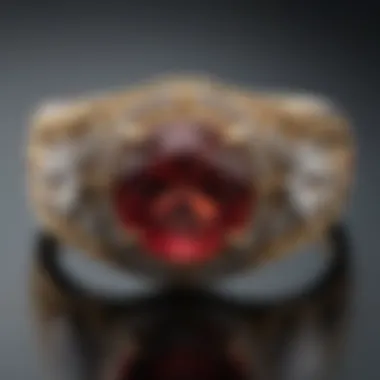
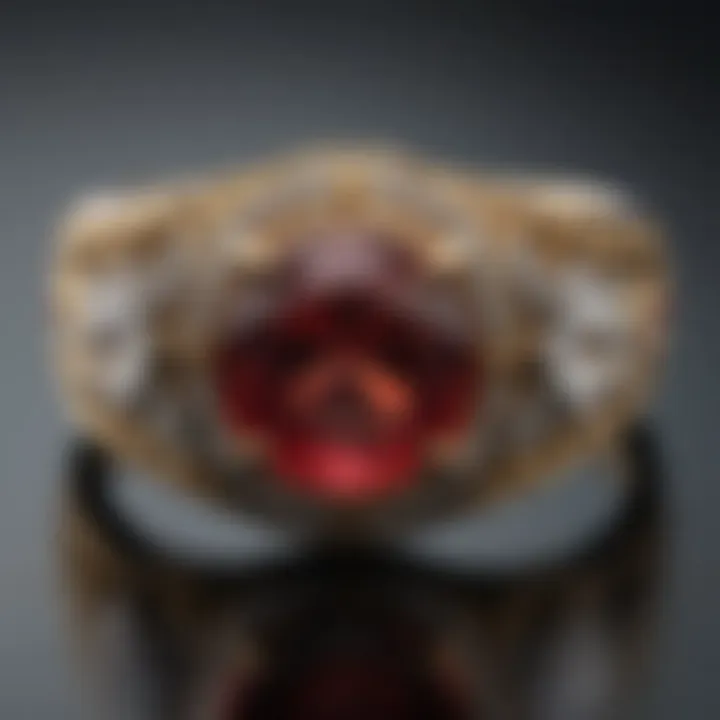
Cultural Significance of Vintage Gemstone Rings
Vintage gemstone rings are more than mere ornamental pieces; they carry profound cultural narratives and social meanings that resonate across different societies and eras. From ancient civilizations to modern-day customs, these rings embody stories of love, power, and identity. The use of specific gemstones and designs reflects the beliefs, traditions, and values that have evolved over time, making each ring a symbol of its cultural context.
Symbolism in Different Cultures
Across various cultures, gemstones embedded in vintage rings often held deep significance. For instance, in many Indian traditions, the use of colorful stones like rubies and emeralds signifies prosperity and auspicious beginnings. When worn during wedding ceremonies, these gemstones are believed to bring good fortune and happiness to the couple.
In Western culture, the diamond has evolved as a universal symbol of love and commitment, often associated with engagements and weddings. The saying "Diamonds are forever" encapsulates the sentiment behind the investment in these stones, underlining the value placed on eternal love.
Similarly, in ancient Egypt, gemstones were revered both for their beauty and as shields against malevolent forces. Rings crafted with lapis lazuli, for example, were commonly worn by pharaohs, believed to provide protection and enhance their connection to the divine.
Here are some notable examples of gemstones and their cultural symbolism:
- Turquoise: Often associated with healing and protection, it was used in Native American jewelry, imbuing rings with spiritual significance.
- Amethyst: In ancient Greece, it was believed to ward off intoxication, making it popular among the nobility for both its beauty and purported protective qualities.
- Pearl: Often seen as a symbol of purity and innocence, pearls were traditionally used in bridal jewelry across various cultures, reinforcing the significance of the occasion.
Rings in Wedding Customs
The significance of vintage gemstone rings is perhaps most acutely observed in wedding customs. Whether it's the simple gold band or an elaborate piece studded with precious stones, these rings represent a formal commitment between partners. Different cultures incorporate various gemstones into their wedding rings, with each choice often symbolizing unique traits or qualities desired in a marriage.
In some Western traditions, the engagement ring is typically adorned with diamonds, symbolizing strength and resilience in the union. However, increasing trends show couples opting for colored gemstones such as sapphires or emeralds as a way to express individuality and personal taste.
In contrast, cultural practices in other parts of the world can vary significantly. For instance, in many Asian cultures, traditional rings may feature jade, which is highly valued as a symbol of purity and moral integrity. This aligns with the belief that the quality of the gemstone reflects the character of the wearer.
As a couples' journey begins, these rings become cherished tokens, often passed down through generations, embodying family history and the legacies of love.
Underpinning all these customs is the idea that the right vintage gemstone ring can encapsulate a couple's journey, resonating with their unique story and cultural identity.
Vintage gemstone rings hold not just beauty but a profound cultural narrative that shapes their significance in love and tradition.
Modern Trends in Vintage Gemstone Rings
The evolving landscape of vintage gemstone rings, once a niche realm of collectors and jewelry aficionados, is experiencing a renaissance of sorts. This section delves into the modern trends that have significantly shifted the perception and appreciation for these historical pieces. Understanding these trends not only sheds light on current consumer preferences but also emphasizes the blend of timeless elegance with contemporary design sensibilities. In today's market, vintage rings aren’t just relics of the past—they are a celebration of history that continues to inspire modern craftsmanship, making them a hot commodity for both collectors and casual wearers alike.
Revival of Vintage Styles
The resurgence of vintage styles in the jewelry market has emerged as a noteworthy trend. Many people are gravitating towards designs from various historical periods, such as Art Deco, Victorian, and Retro. Each style comes with its own flair, characterized by distinct cuts, settings, and gemstone choices.
- Art Deco Inspiration: The geometric patterns and bold colors of Art Deco rings, featuring diamonds, sapphires, and emeralds, are making waves in modern collections. They fuse rich history with a contemporary aesthetic that appeals to today's buyers.
- Victorian Charm: Rings that showcase intricate metalwork and ornate settings often evoke nostalgia, drawing in those who appreciate the craftsmanship of yesteryears. The romantic symbolism often highlighted in Victorian rings captivates couples seeking unique engagement or promise rings.
- Retro Glam: From the whimsical forms of the mid-20th century to heavier, bold designs, Retro styles stand out for their vibrant colors and playful designs. Many find charm in the flamboyant use of colored gemstones during this era.
This revival is significant; it not only creates an opportunity for artisans to reinterpret established styles but also reinforces the value of craftsmanship in an age dominated by mass production.
The Influence of Social Media
In recent times, social media has played a pivotal role in shaping the trends surrounding vintage gemstone rings. Platforms like Instagram and Pinterest allow users to showcase their collections and offer a glimpse into their style preferences.
- Influencers and Curators: Jewelry influencers often highlight unique vintage finds, educating their audience on the history and significance of these pieces. As followers see these rings styled in everyday outfits, the allure of vintage becomes more mainstream.
- Hashtag Culture: The rise of hashtags like #VintageJewelry and #GemstoneRings facilitates communities where enthusiasts can share their discoveries and collections. This sense of belonging spurs interest and drives individuals to seek out their own vintage pieces.
- Buying and Selling: Platforms such as Etsy and eBay have seen a rise in listings for vintage gemstone rings, with social media driving potential buyers to shop online. The visibility of these platforms makes it easy to stumble upon one-of-a-kind pieces that might otherwise remain obscure.
"Social media does not merely serve as a marketing channel; it has dramatically democratized the jewelry ownership experience, making vintage pieces desired and attainable by a wider audience."
By weaving together nostalgia with the convenience of online shopping, these modern trends successfully merge the past with the present, ensuring that vintage gemstone rings remain relevant to today’s jewelry enthusiasts.
Closure: The Lasting Appeal of Vintage Gemstone Rings
Vintage gemstone rings hold a unique charm that resonates with both history and personal expression. The allure of these pieces transcends mere adornment; it often embodies stories, emotions, and legacies passed down through generations. Understanding the lasting appeal of these rings gives us insight into their significance in the jewelry landscape and, indeed, our lives.
Timeless Beauty and Value
The enchantment of vintage gemstone rings lies in their timeless beauty. Unlike many contemporary pieces, such rings often feature intricate craftsmanship that reflects the artistry of bygone eras. Each ring serves as a testament to the skills of artisans who meticulously carved, set, and polished each gemstone. Think about the delicate filigree work of a Victorian ring or the bold geometric styles from the Art Deco period. These designs have not just stood the test of time; they continue to inspire modern jewelers.
Moreover, vintage rings often appreciate in value. As collectors seek unique pieces that convey history and artistry, the rarity of these gems can enhance their market appeal. Sapphires, emeralds, and rubies, which have long been favored in this realm, possess not just beauty but an emotional resonance associated with their rich lore. Owning a vintage gemstone ring is akin to possessing a piece of art that can be handed down through generations, representing shared history and memories.
Preserving Heritage Through Jewelry
Owning a vintage gemstone ring is like holding a piece of heritage in your hand. Each ring carries a narrative—of love, of culture, of artistry. Jewelry has always played a crucial role in traditions and customs worldwide; rings symbolize commitment, family ties, and cultural milestones. Their enduring presence in wedding customs across different cultures is noteworthy. For instance, in many Western cultures, the diamond engagement ring is a well-trodden path, while in others, colored gemstones are often preferred, reflecting the cultural significance.
Additionally, the act of preserving these rings ensures that we honor those who came before us. Through careful maintenance and understanding of the history involved, modern wearers can connect to the full tapestry of life experiences encapsulated in these pieces. So not only do vintage gemstone rings serve a personal purpose, but their preservation also supports cultural continuity and shared identity.
In summary, understanding the lasting appeal of vintage gemstone rings goes beyond their aesthetic attraction. They offer a glimpse into the stories and traditions that have shaped our world. The journey from creation to wear contributes to a rich narrative, making these rings far more than just adornments.



